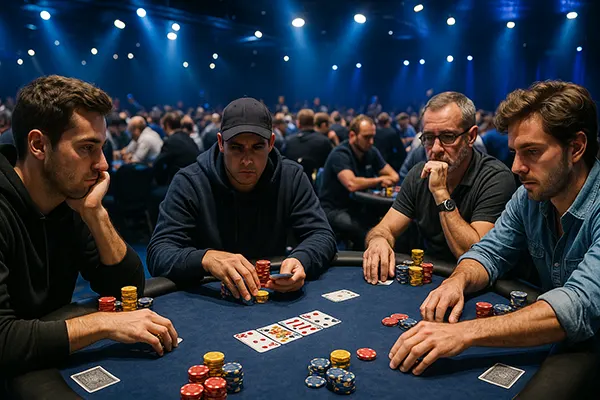
Evolution of Tournament Poker Strategies: From Freezeouts to Modern Formats
Tournament poker has undergone a profound transformation over the past few decades, evolving from simple freezeout formats into a complex ecosystem of structures designed to suit every kind of player and bankroll. This evolution reflects not only the development of poker theory but also the influence of technology, live event innovation, and player psychology.
The Classic Era of Freezeout Tournaments
In the early days of professional poker, the freezeout format was the gold standard. Every participant started with the same number of chips and played until only one remained. This structure created a pure, merit-based competition where survival and discipline were key. The World Series of Poker (WSOP) built its legacy on freezeouts, with legends like Doyle Brunson and Johnny Chan defining the strategic approach of that era.
Freezeouts emphasised patience and long-term decision-making. Players focused on selective aggression, preserving their stacks until the right moment to strike. Bluffing was rarer and more calculated, as one mistake meant instant elimination. The strategy leaned heavily on psychology and reading opponents rather than relying on mathematical models or data-driven analysis.
As poker grew globally, freezeout events remained respected but limited in accessibility. High buy-ins excluded casual players, while the single-elimination nature restricted participation. These limitations laid the groundwork for the next stage in poker’s evolution — the satellite era.
The Rise of Satellite Qualifiers
Satellite tournaments emerged as a solution for players with smaller bankrolls, allowing them to earn entry into prestigious main events. The concept, popularised in the 1980s and 1990s, revolutionised the poker world. It offered an opportunity for anyone to compete for life-changing prizes with minimal investment. Chris Moneymaker’s 2003 WSOP Main Event victory, after qualifying through an online satellite, became the defining moment that inspired the global poker boom.
Strategically, satellite events demanded a different mindset. Instead of playing to win every chip, players aimed to survive long enough to secure a seat. Risk management, ICM (Independent Chip Model) awareness, and adaptability became essential. Professionals began developing hybrid strategies that balanced aggression with preservation, a skill that remains vital in modern tournaments.
Satellite formats also encouraged broader participation and inclusivity, giving rise to a diverse player pool and stimulating the online poker industry. They bridged the gap between amateurs and professionals, democratising the path to high-stakes poker success.
The Expansion of Multi-Table Tournaments (MTTs)
The introduction of multi-table tournaments marked a turning point in poker’s structure and strategy. Unlike single-table events, MTTs demanded endurance, adaptability, and an understanding of shifting dynamics as tables consolidated. Online poker further amplified this evolution, hosting thousands of players simultaneously and introducing structures that blended deep stacks with turbo levels for faster play.
Strategically, players began adopting data-driven approaches. Analytical tools and hand-tracking software became common, enabling players to refine ranges and optimise decisions. Game theory optimal (GTO) concepts gained traction, helping professionals maintain balance in unpredictable environments. Mastering variance management became as important as mastering hand selection.
MTTs created an entirely new ecosystem of professional players — specialists who thrived on volume and strategic precision. This era also saw the rise of major online series such as the World Championship of Online Poker (WCOOP) and live circuits like the European Poker Tour (EPT), further professionalising the game.
Adapting to Changing Dynamics
As field sizes grew, so did the need for nuanced strategies. The introduction of re-entry formats, late registration, and progressive knockouts (PKOs) transformed how players approached tournament phases. Early-stage play became more flexible, while bubble and final-table tactics evolved to account for modern structures.
Professional players began balancing GTO fundamentals with exploitative tactics, targeting weaker opponents while adjusting to meta-game trends. Bankroll management became central, as variance increased dramatically in large-field MTTs. Consistency and emotional control distinguished elite professionals from recreational participants.
Technological progress also influenced tournament preparation. Players now studied advanced solver outputs, participated in training groups, and used databases to analyse population tendencies. The modern MTT grinder operates with precision that early-era players could scarcely imagine.

The High-Roller and Modern Poker Era
The modern poker landscape is defined by innovation and exclusivity. High-roller tournaments, featuring buy-ins of $25,000 and beyond, attract elite professionals and wealthy enthusiasts alike. These events combine prestige with cutting-edge structure design, including deep stacks, shot clocks, and re-entry options that enhance competitive balance.
Strategically, high-rollers are the pinnacle of poker theory in action. Every decision is dissected through the lens of GTO and opponent modelling. Players invest heavily in coaching, solvers, and statistical analysis to gain marginal edges. Bluff frequencies, bet sizing, and ICM pressure are optimised to an extreme degree, making these events a showcase of pure skill and psychological warfare.
Meanwhile, innovation continues to reshape the game. Hybrid live-online events, mystery bounties, and fast-structured hyper tournaments keep the ecosystem vibrant. These formats appeal to both professionals seeking challenge and casual players drawn by creative incentives. The evolution of tournament poker, therefore, remains ongoing — a reflection of human adaptability, competitive spirit, and the unending pursuit of mastery.
Future of Tournament Strategy
Looking ahead to 2025 and beyond, tournament poker will likely embrace even more integration between live and digital play. Artificial intelligence-driven analysis and real-time strategy tools are poised to redefine how players prepare and adapt during events. However, the core principles — discipline, emotional control, and strategic understanding — will continue to separate winners from the rest.
Modern players must balance theoretical knowledge with intuitive adaptability. Success will depend not only on mastering mathematics but also on reading human behaviour in increasingly hybrid environments. The line between data and instinct will continue to blur, giving rise to a new generation of analytical yet creative players.
Ultimately, the story of poker’s strategic evolution is one of innovation meeting tradition. From the humble freezeout tables of Las Vegas to today’s global high-roller circuits, poker remains a timeless test of skill, intellect, and resilience.





